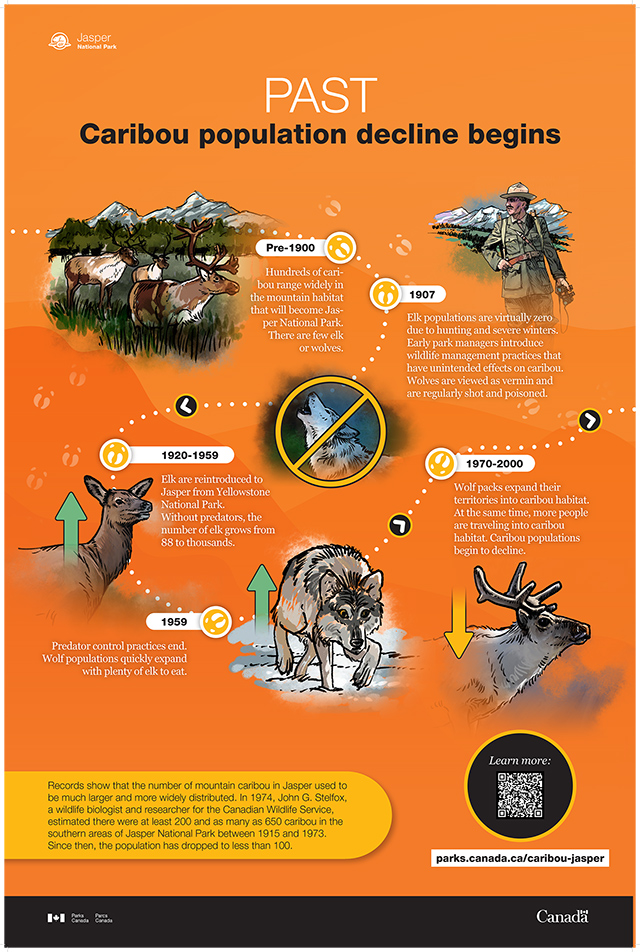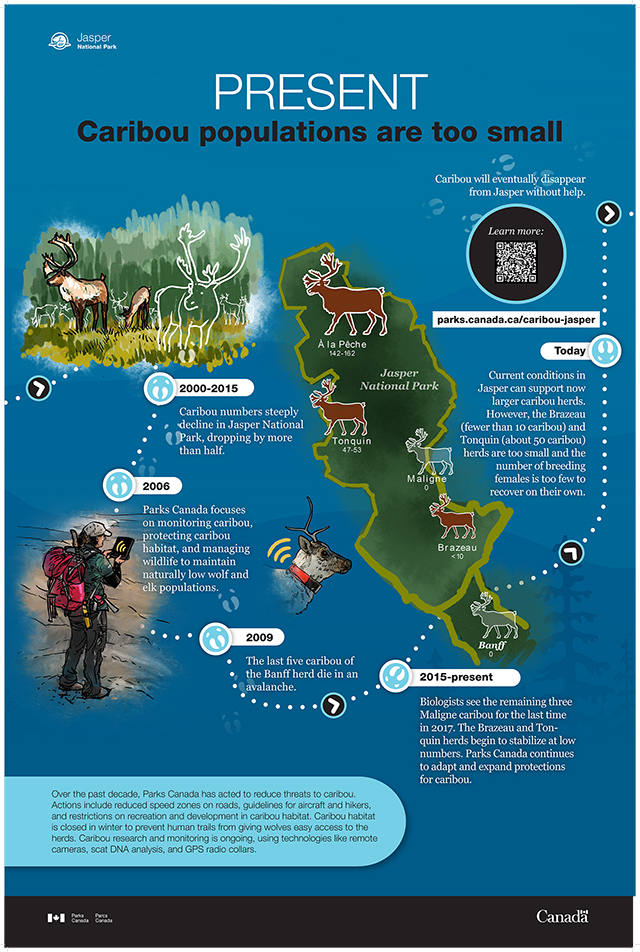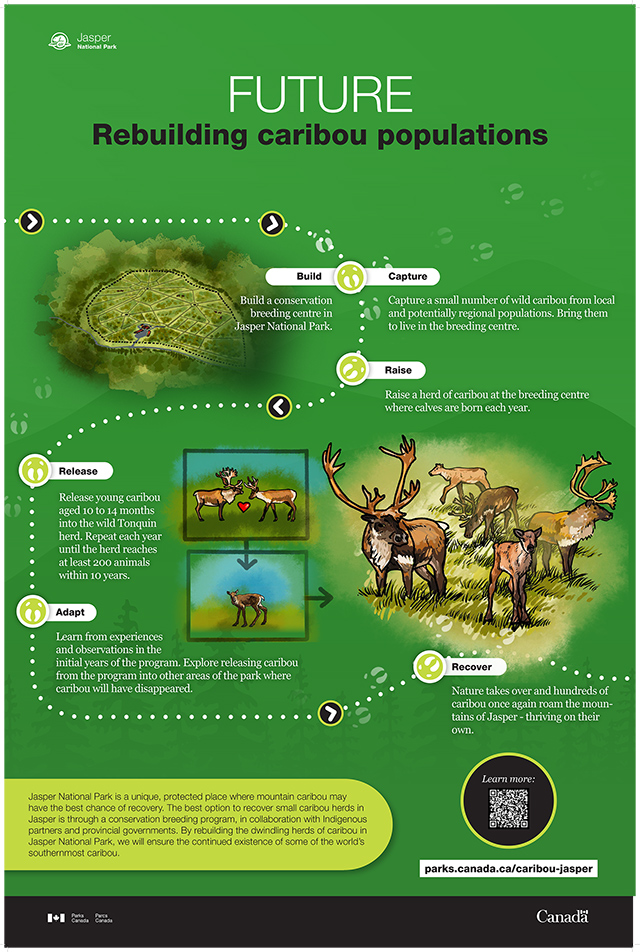
Caribou recovery
Jasper National Park
Keeping caribou on the land
Indigenous knowledge holders and archaeologists know that humans and caribou have shared the lands in what is now Jasper National Park for thousands of years. A very old caribou antler found preserved in an ice patch shows that caribou have existed here for at least 1300 years.
Mountain caribou depend on vast and undisturbed habitats. Over the last fifty years, mountain caribou herds in Alberta and British Columbia have gotten smaller in number and some herds have disappeared. Protected areas like national parks are key for their survival.
Parks Canada, in collaboration with partners, is working to protect and recover caribou in Jasper National Park. Our goal is to support caribou to once again thrive on their own.
Get to know caribou
How we are helping
Past, Present and Future

Text version
Caribou population decline begins
Pre-1900
Hundreds of caribou range widely in the mountain habitat that will become Jasper National Park. There are few elk or wolves.
1907
Elk populations are virtually zero due to hunting and severe winters. Early park managers introduce wildlife management practices that have unintended effects on caribou. Wolves are viewed as vermin and are regularly shot and poisoned.
1920–1959
Elk are reintroduced to Jasper from Yellowstone National Park. Without predators, the number of elk grows from 88 to thousands.
1959
Predator control practices end. Wolf populations quickly expand with plenty of elk to eat.
1970–2000
Wolf packs expand their territories into caribou habitat. At the same time, more people are traveling into caribou habitat. Caribou populations begin to decline.
Records show that the number of mountain caribou in Jasper used to be much larger and more widely distributed. In 1974, John G. Stelfox, a wildlife biologist and researcher for the Canadian Wildlife Service, estimated there were at least 200 and as many as 650 caribou in the southern areas of Jasper National Park between 1915 and 1973. Since then, the population has dropped to less than 100.
Map
À la Pêche 142-162; Tonquin 47-53, Maligne 0; Brazeau fewer than 10; Banff 0

Text version
Caribou populations are too small
2000–2015
Caribou numbers steeply decline in Jasper National Park, dropping by more than half.
2006
Parks Canada focuses on monitoring caribou, protecting caribou habitat, and managing wildlife to maintain naturally low wolf and elk populations.
2009
The last five caribou of the Banff herd die in an avalanche.
2015–present
Biologists see the remaining three Maligne caribou for the last time in 2017. The Brazeau and Tonquin herds begin to stabilize at low numbers. Parks Canada continues to adapt and expand protections for caribou.
Today
Current conditions in Jasper can support larger caribou herds. However, the Brazeau (fewer than 10 caribou) and Tonquin (about 50 caribou) herds are too small and the number of breeding females is too few to recover on their own.
Caribou will eventually disappear from Jasper without help.
Over the past decade, Parks Canada has acted to reduce threats to caribou. Actions include reduced speed zones on roads, guidelines for aircraft and hikers, and restrictions on recreation and development in caribou habitat. Caribou habitat is closed in winter to prevent human trails from giving wolves easy access to the herds. Caribou research and monitoring is ongoing, using technologies like remote cameras, scat DNA analysis, and GPS radio collars.
Map
À la Pêche 142-162; Tonquin 47-53, Maligne 0; Brazeau fewer than 10; Banff 0

Text version
Rebuilding caribou populations
Build
Build a conservation breeding centre in Jasper National Park.
Capture
Capture a small number of wild caribou from local and potentially regional populations. Bring them to live in the breeding centre.
Raise
Raise a herd of caribou at the breeding centre where calves are born each year.
Release
Release young caribou aged 10 to 14 months into the wild Tonquin herd. Repeat each year until the herd reaches at least 200 animals within 10 years.
Adapt
Learn from experiences and observations in the initial years of the program. Explore releasing caribou from the program into other areas of the park where caribou will have disappeared.
Recover
Nature takes over and hundreds of caribou once again roam the mountains of Jasper - thriving on their own.
Jasper National Park is a unique, protected place where mountain caribou may have the best chance of recovery. The best option to recover small caribou herds in Jasper is through a conservation breeding program, in collaboration with Indigenous partners and provincial governments. By rebuilding the dwindling herds of caribou in Jasper National Park, we will ensure the continued existence of some of the world’s southernmost caribou.
News and updates
- On February 27, 2023, the Honourable Steven Guilbeault, Minister of Environment and Climate Change and Minister responsible for Parks Canada, announced plans to move forward on a new caribou conservation breeding program to support southern mountain caribou recovery in Jasper National Park.
- Now available online: a summary of caribou conservation in Jasper National Park and Parks Canada’s new conservation breeding program.
- Now available online: A report on what we heard during consultations about the conservation breeding program between April 1 and September 2, 2022.
Newsletters
Caribou newsletters since October 2020 are available to read on the Jasper National Park newsletter page.
Take part
Join our mailing list
Join our mailing listFollow the caribou story on our social channels
Join the conversation by using #jaspercaribou
Check out some organizations working to help mountain caribou:
Contact
Caribou Recovery Program
780-883-0391
caribou@pc.gc.ca
- Date modified :







